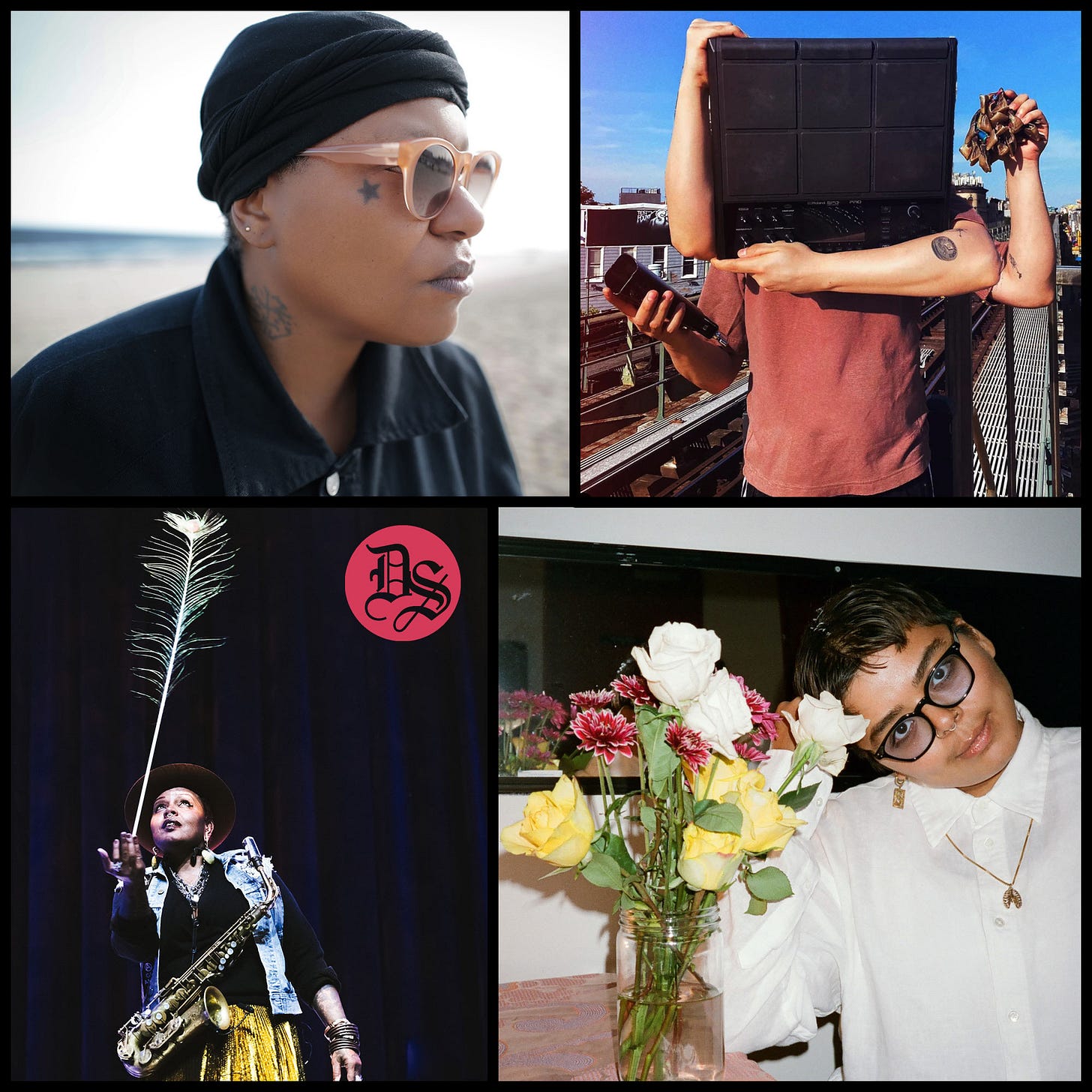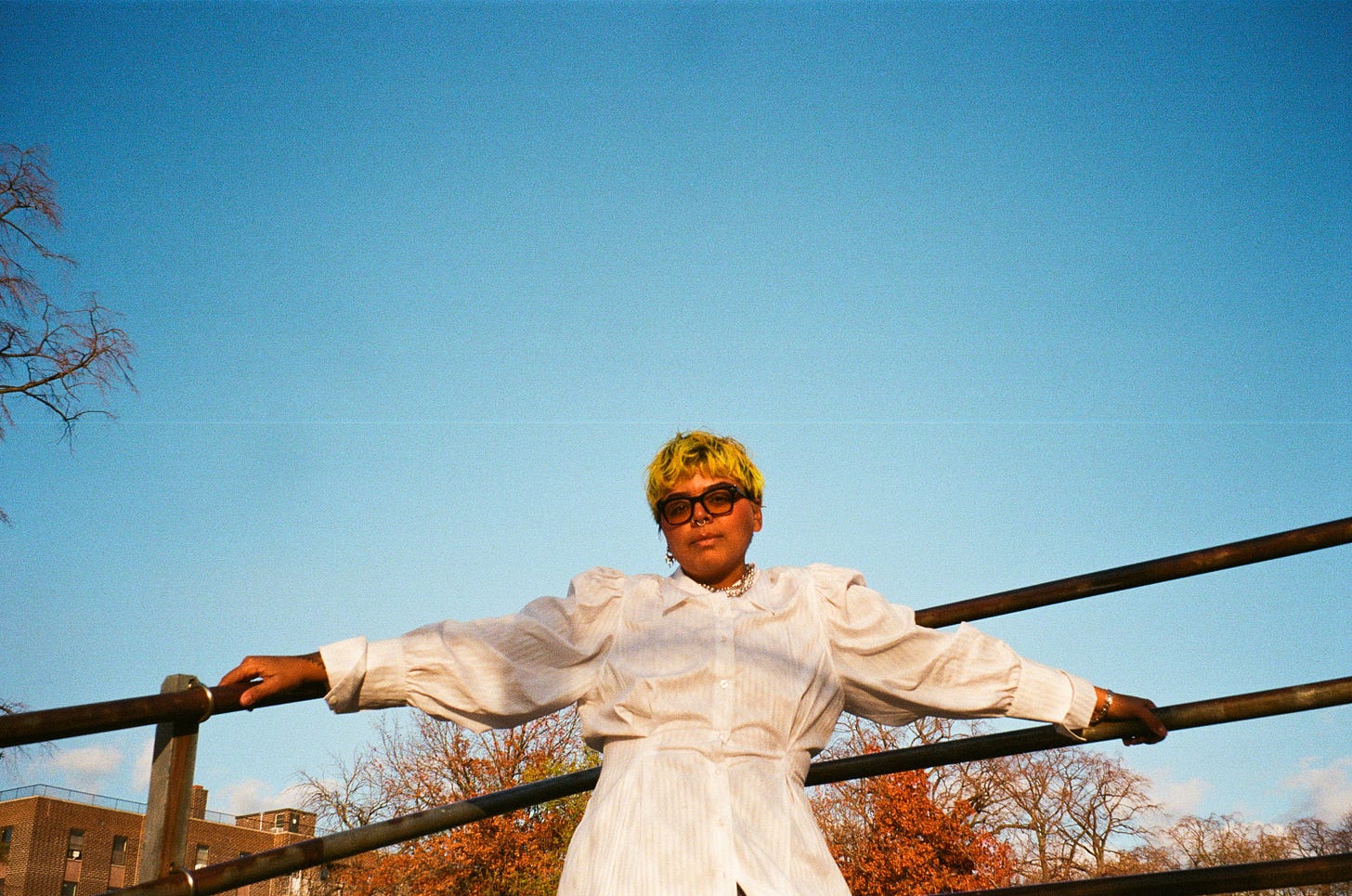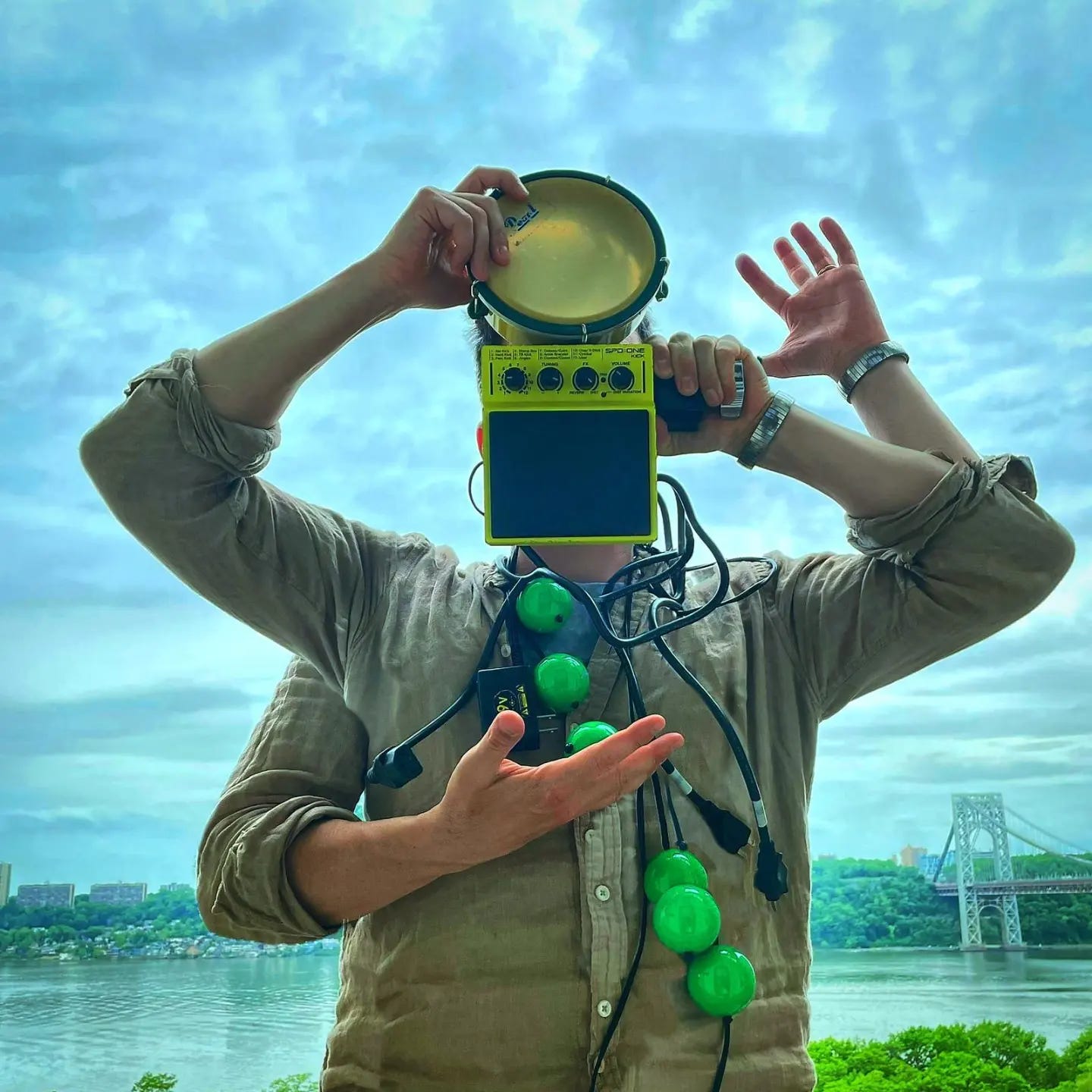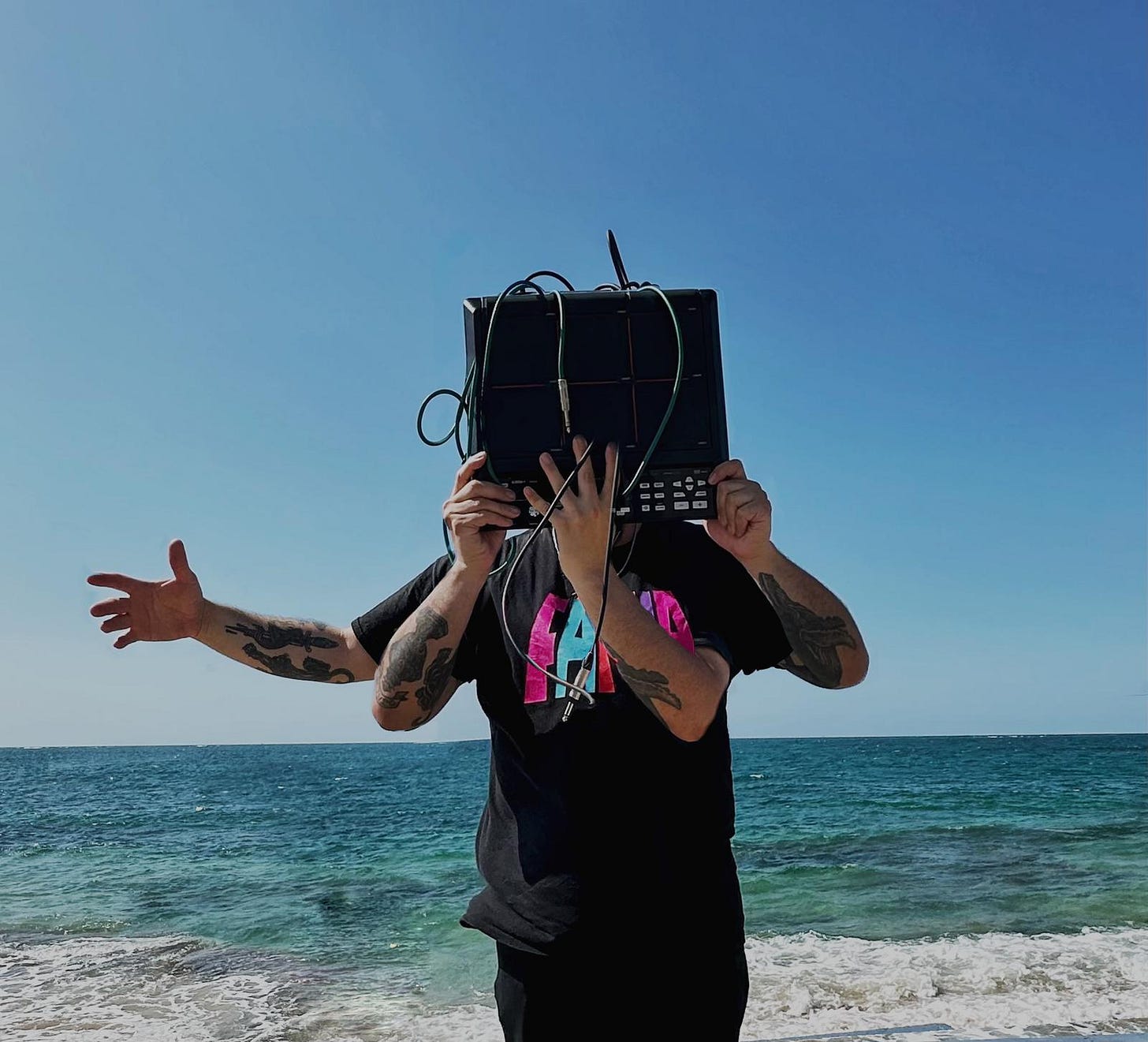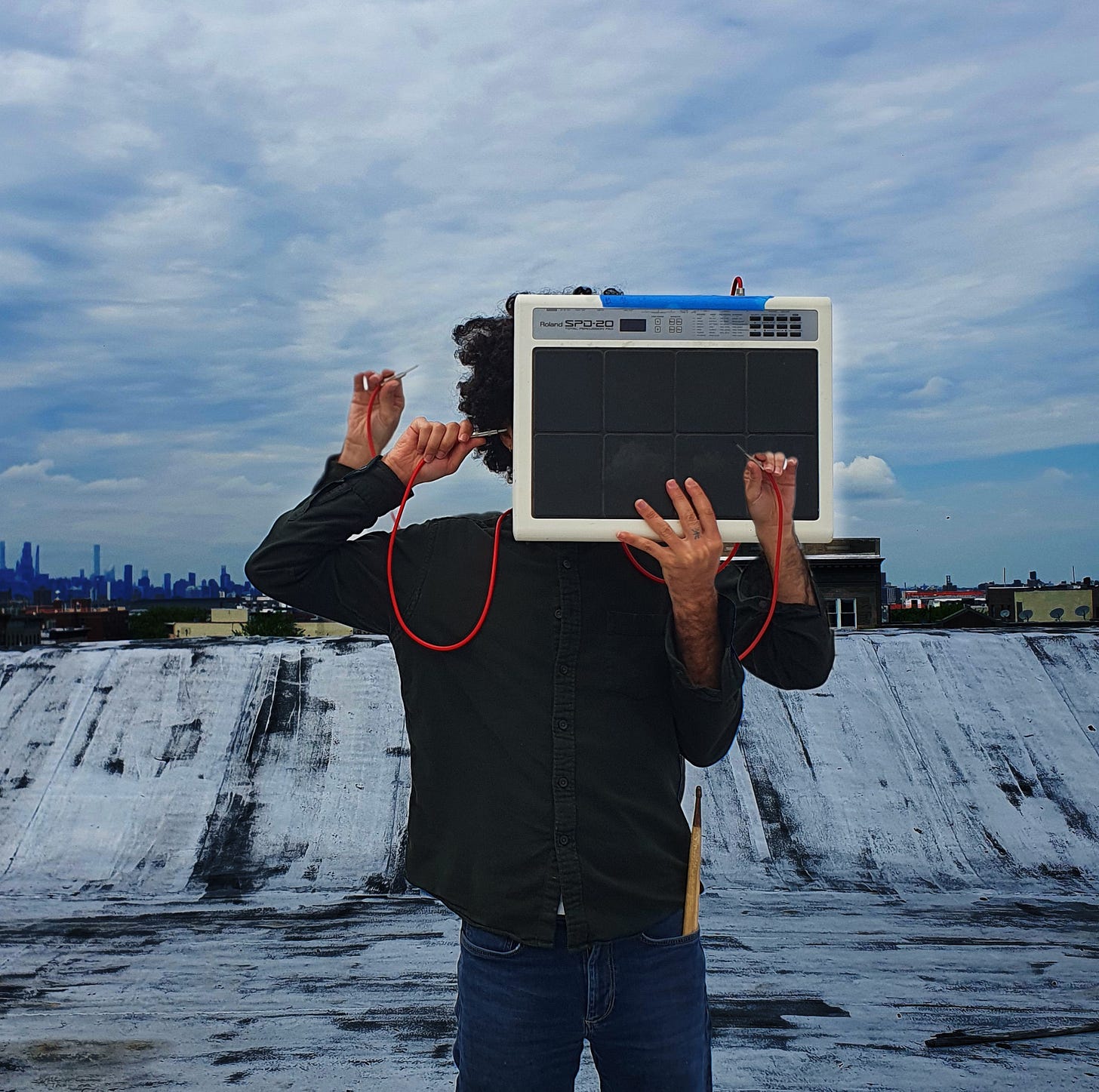STEFA* & A.B.E.L.A. in Their Own Words | Bklyn Sounds 8/1/2024—8/6/2024
Two short Q&As with artists performing live @ 'Ritmo, Improvisación, Electricidad' on Aug 8th + This Week's Shows include: Meshell Ndegeocello / Matana Roberts / Shara Lunon's 'Heavy Florals' / +
On Tuesday, I announced that Dada Strain is co-producing Ritmo, Improvisación, Electricidad at Industry City in Sunset Park, on Thursday, August 8th. It’s an evening that features New York-based Latinx musicians who work with rhythm and electronics — DJing by Mickey Perez and Toribio, and live sets by STEFA* and A.B.E.L.A. (Asociación de Bateristas ElektrónikXs de Latinoamerika) — all of whom Dada Strain has been loudly, proudly and deeply supportive of as great current local artists. Some of them are better known than others, so I asked stefa marin alarcon (aka STEFA*), plus A.B.E.L.A.’s Raimundo Atal and Ernesto Parada to answer some questions about themselves and their work. For those of you unfamiliar with their approaches to rhythm-improvisation-community, I am over-the-moon excited for get to know these artists, and hopefully to experience what they bring into the world.
STEFA*
I’d seen STEFA*’s name listed a few times on local bills before finally getting to experience them live for the first time in early 2023, in the basement at 49 Shade. stefa played synth, looped their vocals, and sang heartbreakingly, beautifully in Spanish and English. The result was a kind of futuristic ambient torch music. A couple of weeks later, I went to see Xenia Rubinos play at Elsewhere, and lo and behold, there was STEFA* as a vocal and choreographic foil for Xenia’s physical, conceptually heady live show. Afterwards I began stanning stefa maria alarcon, ascertaining that they was a born-and-bred New Yorker (Queens), went to LaGuardia, was a classically trained vocalist and theatre student, and more recently a film-maker whose experimental ritual performance short-film, Born With an Extra Rib, won the 2022 the Queer|Art|Prize for Recent Work and a Jury Award at the 2023 TRANSlations Seattle Film Festival.
Born With an Extra Rib also happens to be the name of an extraordinary full-length album STEFA* released a few weeks ago on Bklyn’s Figure & Ground Records. It’s wonderful singer-songwriter work, filled with personal narrative and stage drama, globally swinging drum machines and wide-open synths, sometimes turning towards industrial punk and sometimes towards electronic ethnography. Like much of the art I’ve experienced by STEFA*, it is immense in its creative scope but precise in its prescribed meaning: a great work of art that bears distinct hallmarks of Queer, Latinx storytelling, as ready for a DJ to “just hit it” as for a symposium. Watch their space! (Thank you stefa.)
How/when did you first start thinking seriously about music, and how did you first start approaching the idea of it as your calling or your vocation?
stefa marin alarcon: I was always very passionate about music as a child. It came very naturally to me, and when I realized that having an interest in singing could get me out of the house, I was able to go after opportunities that would put me around other musicians and artists. I was doing this at a very young age, around eight years-old. I kept chasing the feeling I got when I was singing: not only attention from others (my teachers, my parents, an audience), but I got to take time and space away from the stressful parts of my family, and being bullied. I really got to embrace that part of me when I found other weirdos, and knowing that I wasn’t alone, my little self got to experience freedom through song and performance. I carried that with me through my early 20s. Then in my mid- to late-20’s, I thought, “Hey, why don’t I do this.” I didn’t know what it was exactly that I wanted to do, but I knew I wanted to take back my voice and my story after years of conservatory. I’m still learning how to Do It in a way that feels true to me.
I understand that you grew up in Queens as a first-generation immigrant (me too), and I’m always curious how the mix of the big city and the local immigrant neighborhood affects people's work. Which parts they want to keep, and which parts they want to discard. Can you share a bit about how your Colombian-American-NYC childhood influences the music you make?
I’ve called my music “Queens sounds” before because I think of my music as a home that holds many stories, influences, and dreams. With my music, I dream of safety for myself, my trans kin, and my migrant family; and I try to create that space for others to feel and to heal. Telling stories about working-class people, about trans people, about mothers, about the Earth, these are all themes that I heard through the cumbia, salsa, boleros and vallenatos that I was listening to growing up.
When people ask you to describe what kind of artist you are, how do you answer? I ask because in just the couple of years that I've followed your work, I’ve heard you as a singer-songwriter and vocalist, bandleader and producer. I've seen you as a player in a production. I also know that you’re a visual artist; and much of your music comes with narrative underpinnings, so storytelling is obviously important. In your head, how do you regard your practice, and how do you describe it to others?
I worked really hard to believe myself when I say, “I am an artist.” I’ve created worlds with my work that have given me agency to say, “I am a trans-disciplinary artist.” I feel like I knew what I wanted to be, and how I wanted to take up space before I actually had the repertoire to back it up! But I saw the possibilities when I saw artists be unapologetic in their interests, and in the way they express themselves. I’m still trying to reach those expansive spaces of my craft. At the moment I use words like vocalist, filmmaker and composer to describe what I do and what I want to continue to do.
A.B.E.L.A.
As with STEFA*, I also first experienced A.B.E.L.A. at a DIY-booked show, this one at Trans-Pecos in Ridgewood. (Shout-out DJ Undisclosed Locations, and to everyone producing performances by great local artists in their homes and at clubs simply because you believe in their work.) A.B.E.L.A. was on a bill alongside a few of my friends, but was also counter-programmed directly against the Super Bowl. Uninterested in the the football spectacle, I stuck around to check out what was going on because the few clips that were posted on IG revealed, potentially, a drum troupe of my dembow-techno dreams. That Trans-Pecos show, played to a largely empty room, felt musically transcendent. As in, “if that’s how good they are here, how explosive might they be before a large audience?” I had no names and no context for the group — A.B.E.L.A. has been just mysterious enough to make Internet users work for details, often to no avail. But I DM’d the account, started talking to Raimundo Atal, the “secretary general of the sindicato…in charge of the kick drum and phone calls,” and soon we had a plan. Now we have a show - and a short interview. The context is growing. Thank you Raimundo and Ernesto for your time. Viva el Sindicato!
A.B.E.L.A. stands for Asociación de Bateristas ElektrónikXs de Latinoamerika. It is also a collective. Can you tell me a little bit about who is in the collective, and how it came together?
Raimundo Atal: There are exactly 15 people that are part of A.B.E.L.A. All latinamerican drummers, from Colombia, Chile, Puerto Rico, Argentina, Ecuador, Brazil, Bolivia. They are all active performers, each doing their own thing in the city and around the world. A.B.E.L.A. started during the last of a series of shows I had at Hart Bar. I thought it would be cool to have an “e-drum circle” (a drum circle but with electronic drums). After doing a lot of ambient-y stuff, I needed to go back to some beats. Pablo Eluchans, Joel Mateo, and el Primo Burgos were there for the first e-drum circle. Quetzal, who was doing sound that night, gave us the name; I don’t remember if it was exactly Asociacion de Bateristas Electronicos, or something very close. Then came the acronym, A.B.E.L.A. We had lots of fun, and agreed we had to repeat it. We then played a party where we did a set back-to-back with Jose Berrios, (a.k.a. Bataca), who was DJing. Jose is also a drummer, and Colombian, so that night he joined. Then we got invited to other shows and so on…. Along the way, all of our friends who are latinamerican drummers and have an electronic side have joined A.B.E.L.A. Big Shout-out to everyone who has organized shows and invited us: Julia Santoli, Barrio Collective, Andrea Velasco, La Vecindad, Martina, John Pugh, 764 Greene and so many others.
Ernesto Parada: This isn't just a band; it's a fluid and vibrant community where musicians come together to explore the intersection of traditional rhythms and modern electronic sounds. The members of A.B.E.L.A. rotate depending on the context and the performance, ensuring that each show is a unique and immersive experience. The collective is made up of a diverse group of Latinx musicians, each bringing their own unique background and expertise to the table. While specific members might change, the essence of A.B.E.L.A. remains constant: a dedication to pushing the boundaries of rhythmic and electronic music. A.B.E.L.A. came together as a fusion of like-minded individuals who sought to create something new and organic, blending their love for traditional Latin American percussion with cutting-edge electronic music.
I’ve been describing A.B.E.L.A. as an "electronic drum-circle ritual," and being very much about the mixture/integration of rhythmic traditions. Tell me a little bit about how you/the group regard the relationship between drums and electronics?
Ernesto: Describing A.B.E.L.A. as an "electronic drum-circle ritual" perfectly encapsulates the spirit of the collective. At its core, A.B.E.L.A. is about the seamless integration of rhythmic traditions with electronic innovations. The members see no boundary between drums and electronics. Instead, we view them as complementary forces that can enhance each other. The electronic elements allow for new textures and layers, while the traditional drums root the music in a rich cultural heritage. This blend creates a powerful and hypnotic sound that is both timeless and contemporary.
Raimundo: Thanks for describing it as a ritual. I think music, broadly, has that dimension to it. I even think it's one of music’s "missions." Yes, we are definitely mixing and integrating many different rhythmic traditions. We all come from very different backgrounds musically, and very different life experiences, so it's great how that comes together. But it’s not only our latinamerican traditions — it’s everything we experience and work on. Living in NYC shakes everything up! I think there is so much to explore in the translation of what we could call our (drum) "traditions" into electronics. I think it's like nuclear power. Plus traditions are a living thing, and I think electronics are now kind of a part of our traditions.
I think it’s also important that we are having fun, fucking around, and like to make people dance at our shows, not really thinking about it that much. I guess that's when tradition really shows up HA! Blending drums and electronics can be everything: life and death, love and war. Electronics, like drums, can be tools that reinforce. Think drum machines, SPDs, modulars, DAWs and their beat-making capabilities. It’s an endless world, full of possibilities, chances, smiles, mistakes, life! It's really amazing and I feel so lucky I get to explore that with such talented musicians.
Though A.B.E.L.A. has played a few gigs, and its members all perform regularly, there is no A.B.E.L.A. music out on the socials, which is such a rarity nowadays, when self-promo rules everything around us. Which leads me to ask: How do you all regard the project? Is this a working band? An idea among friends and colleagues about a band? An occasional improvisational happening? And does it have a future?
Raimundo: No A.B.E.L.A. music out in the socials, but I hope we can record and put out some things soon. It is, all at the same time, a working band, an idea among friends and colleagues, and an improvisational happening. But it is also more, I think. Although there is of course some leadership, we think of it as a “collective.” Actually, we think of it as some sort of union (we do call it El Sindicato, the union). We even have some protocols on, for example, how shows are organized, communicated, how money is distributed, etc. There are 15 of us — and growing, nationally and internationally — and the idea is to make it as participatory and horizontal as possible. In the future, , we’re open to wherever those principles, our work and other people’s good will take us. Musically, it has been evolving. First shows were full improvisation; but we have now developed some structures and a language to communicate on stage. We are trying to figure out the way to translate this working-method/union system to record music. It's not obvious, because of how participatory we want it to be and everybody is very busy. But I think we are very close to figuring it out. We also think a lot about our profession, and how fucked up everything is. Eventually A.B.E.L.A. will be a platform to fight for the rights of drummers and others! Personally, I’d love for A.B.E.L.A. to keep growing based on those principles. So let’s see where that will take us!
Ernesto: Despite the collective's growing popularity, you won't find A.B.E.L.A.'s music on social media or streaming platforms. This rarity is intentional and speaks to the ethos of the group. A.B.E.L.A. is more of an improvisational happening than a traditional band. Each performance is a one-of-a-kind experience, shaped by the moment and the musicians involved. This spontaneity emphasizes the live, communal aspect of their music, making each gig a unique event. A.B.E.L.A. is an ongoing experiment, a work in progress that continually evolves. The collective's members see it as a platform for creative exploration and collaboration, rather than a fixed entity. As they move forward, they remain open to new ideas, influences, and directions. The future of A.B.E.L.A. is unwritten, and that's precisely what makes it so exciting. It's a living, breathing project that grows and changes. In essence, it’s more than just a collective of musicians, but a movement that challenges conventional notions of music and performance. By embracing the fluidity of its membership and the spontaneity of its shows, A.B.E.L.A. creates a unique and unforgettable experience that transcends the traditional boundaries of genre and form.
STEFA* and A.B.E.L.A. with Mickey Perez and Toribio at Ritmo, Improvisación, Electricidad (Thurs 8/8, 6p @ Industry City, Sunset Park - FREE)
This Week’s Shows:
Free jazz gigs paid for by real estate concerns simply don’t get any better than this! Harpist Brandee Younger and drummer Makaya McCraven are regular colleagues, and bassist Rahsaan Carter has been providing low-end in Younger’s bands for at least a few years now. They’ll get ethereal, they’ll get funky, they’ll go out and come back in the pocket. Guaranteed! Before and after, you get one of Bklyn’s unofficial mayors, DJ Spinna, on the 1s and 2s. Highest Recommendation. (Thurs 8/1, 6p @ Industry City Courtyard, Sunset Park - FREE)
Trance & Dance is billed as “a night of ecstatic music from North Africa and the Middle East.” The live shows by its featured performer, NYC-based Moroccan bandleader, the gimbri player and singer Samir Langus, are wonderful exercises in North African rhythm and improvisation joy, especially at Nublu, his regular haunt. The DJ before and after, Omar Aena (born in NYC, Iraqi parentage), weaves a wonderful spiritual music tapestry for the dance-floor. (Thurs 8/1, 7p @ Nublu, Loisaida - $20)
Matana Roberts’ journey feels among the heaviest currently ongoing among “successful” improvised music careers. Long past the notion of being merely a “jazz musician,” Roberts has emerged as a historian, a musical and visual storyteller and memoirist, a conjurer of spirits with their horn and voice, exploring America’s dark racial history with their incredible Coin Coin albums. At their The Stone residency, Roberts is performing in a series of trios featuring artists comfortable with the breadth of Black musical and oral traditions in improvised settings, but also comfortable in pushing towards the sonic unknown. Thursday (8/1), Roberts is joined by vocalist Fay Victor and bassoonist Rebekah Heller; Friday (8/2), by vibraphonist Pauline Roberts and bassist Brandon Lopez; and Saturday (8/3), by drummer Tomas Fujiwara and a special guest. (Thurs 8/1—Sat 8/3, 8:30 @ The Stone, New School, Manhattan - $20)
Another week, another great MoMA PS1 Warm-Up line-up. At the top is one of Detroit’s other classics, Terrence Dixon, whose 30+ year career in techno, making great deep music for Metroplex and Tresor is often overshadowed by his more lauded brethren, but which bangs in its own (very Berlin-adjacent way). Also at the top is Laurel Halo, whose austere techno-influenced takes on ambiance are beloved by many. As always with Warm-Up, the locals kicking things off are very worth the early entry: Sadaf is an Iranian-born multi-disciplinary artist, vocalist/violinist/beatmaker, and Havoc on World is the big-room-house DJing/production duo of Monep Neptune and Taylor Cherry. (Fri 8/2, 4p @ PS1 Courtyard, Long Island City - $17-$20)
Though Dada Strain aspires to be nostalgia-free, there’s also a fine line here between sacred history and the sonic pangs of youth: Hence TedSmooth’s Freestyle Jam up in The Bronx, featuring two New York artists who made two of the greatest dance records of the ‘80s. To say C-Bank’s “One More Shot” and Strafe’s “Set It Off” are classics is on some obvious shit, so the opportunity to bask even for a (potentially years-erasing) quarter-hour before their makers is a blessing that should not be taken lightly. Smooth the 94.7FM DJ who does bask in local dance-floor nostalgia has other freestyle-adjacent smarties and legends (to some) on the bill, including Coro, DJ Serg, Antghony Mangini and JayBoogieNYC. (Fri 8/2, 6p @ Crotona Park The Bronx - FREE)
There are few things I love as much as when incredibly talented musicians find a new direction, a different gear, or recharge their creative foundations. Earlier this year, I had an opportunity to talk to Meshell Ndegeocello, and she told me that she “hasn’t been the same since reading” John Szwed’s Sun Ra autobiography, Space Is the Place, during the pandemic, attributing its influence on all her work since then. Ndgeocello has long been an incredible bassist, songwriter bandleader and conceptualist, moving freely from instrumental sojourns to cosmic jams to personal storytelling, unafraid to mix them into a personal stew of rock, funk, jazz, soul and whatever is exciting her at the moment. Meshell’s brand-new album, No More Water: The Gospel of James Baldwin, an homage to the legendary writer and thinker whose centennial celebration starts on the very day her band kicks it at the Lena Horne bandshell, is yet another part of her winning streak. With Talibah Safiya opening. Highest Recommendation! (Fri 8/2, 7p @ Celebrate Brooklyn, Prospect Park - FREE)
Keep reading with a 7-day free trial
Subscribe to Dada Strain to keep reading this post and get 7 days of free access to the full post archives.



